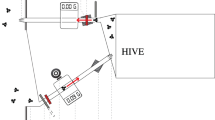Abstract
We studied the extent to which worker honey bees acquire information from waggle dances throughout their careers as foragers. Small groups of foragers were monitored from time of orientation flights to time of death and all in-hive behaviors relating to foraging were recorded. In the context of a novice forager finding her first food source, 60% of the bees relied, at least in part, on acquiring information from waggle dances (being recruited) rather than searching independently (scouting). In the context of an experienced forager whose foraging has been interrupted, 37% of the time the bees resumed foraging by following waggle dances (being reactivated) rather than examining the food source on their own (inspecting). And in the context of an experienced forager engaged in foraging, 17% of the time the bees initiated a foraging trip by following a waggle dance. Such dance following was observed much more often after an unsuccessful than after a successful foraging trip. Successful foragers often followed dances just briefly, perhaps to confirm that the kind of flowers they had been visiting were still yielding forage. Overall, waggle dance following for food discovery accounted for 12–25% of all interactions with dancers (9% by novice foragers and 3–16% by experienced foragers) whereas dance following for reactivation and confirmation accounted for the other 75–88% (26% for reactivation and 49–62% for confirmation). We conclude that foragers make extensive use of the waggle dance not only to start work at new, unfamiliar food sources but also to resume work at old, familiar food sources.





Similar content being viewed by others
References
Adam B (1987) Beekeeping at Buckfast Abbey. Northern Bee Books, Hebden Bridge, Yorkshire
Biesmeijer JC (2003a) The occurrence and context of tremble dancing in free-foraging honey bees (Apis mellifera). Behav Ecol Sociobiol 53:411–416
Biesmeijer JC (2003b) The occurrence and context of the shaking signal in honey bees (Apis mellifera) exploiting natural food sources. Ethology 109:1009–1020
Biesmeijer JC, de Vries H.(2001) Exploration and exploitation of food sources by social insect colonies: a revision of the scout-recruit concept. Behav Ecol Sociobiol 49:89–99
Dornhaus A, Chittka L (2004) Why do honey bees dance? Behav Ecol Sociobiol 55:395–401
Dreller C (1998) Division of labor between scouts and recruits: genetic influence and mechanisms. Behav Ecol Sociobiol 43:191–196
Dyer FC (2002) The biology of the dance language. Ann Rev Entomol 47:917–949
Dyer FC, Seeley TD (1989) On the evolution of the dance language. Am Nat 133:580–590
Farina WM, Wainselboim AJ (2001) Thermographic recordings show that honeybees may receive nectar from foragers even during short trophallactic contacts. Insectes Soc 48:360–362
Esch HE, Zhang SW, Srinivasan MV, Tautz J (2001) Honeybee dances communicate distances measured by optic flow. Nature 411:581–583
von Frisch K (1923) Über die “Sprache” der Bienen, eine tierpsychologische Untersuchung. Zool J Physiol 40:1–186
von Frisch K (1946) Die Tänze der Bienen. Österr Zool Z 1:1–48
von Frisch K (1967) The dance language and orientation of bees. Harvard University Press, Cambridge, Massachusetts
von Frisch K (1968) The role of dances in recruiting bees to familiar sites. Anim Behav 16:531–533
Gil M, Farina WM (2002) Foraging reactivation in the honeybee Apis mellifera L.: factors affecting the return to known nectar sources. Naturwissenschaften 89:322–325
Gould JL (1976) The dance-language controversy. Q Rev Biol 51:211–244
Gould JL, Towne WF (1987) Evolution of the dance language. Am Nat 130:317–338
Johnson DL (1967) Communication among bees with field experience. Anim Behav 15:487–492
Judd T (1995) The waggle dance of the honey bee: which bees following a dancer successfully acquire the information? J Insect Behav 8:343–354
Lindauer M (1952) Ein Beitrag zur Frage der Arbeitsteilung im Bienenstaat. Z Vergl Physiol 34:299–345
Michelsen A (2003) Signals and flexibility in the dance communication of honeybees. J Comp Physiol A 189:165–174
zu Oettingen-Spielberg T (1949) Über das Wesen der Suchbiene. Z Vergl Physiol 31:454–489
Riley JR, Greggers U, Smith AD, Reynolds DR, Menzel R (2005) The flight paths of honeybees recruited by the waggle dance. Nature 435:205–207
Seeley TD (1983) Division of labor between scouts and recruits in honeybee foraging. Behav Ecol Sociobiol 12:253–259
Seeley TD (1985) The information-center strategy of honeybee foraging. Fort Zool 31:75–90
Seeley TD (1995) The wisdom of the hive: the social physiology of honey bee colonies. Harvard University Press, Cambridge, Massachusetts
Seeley TD, Towne WF (1992) Tactics of dance choice in honey bees: do foragers compare dances? Behav Ecol Sociobiol 30:59–69
Seeley TD, Visscher PK (1988) Assessing the benefits of cooperation in honeybee foraging: search costs, forage quality, and competitive ability. Behav Ecol Sociobiol 22:229–237
Sherman G, Visscher PK (2002) Honeybee colonies achieve fitness through dancing. Nature 419:920–922
Siegel S, Castellan Jr NJ (1988) Nonparametric statistics for the behavioral sciences. McGraw Hill, New York
Sokal RR, Rohlf FJ (1981) Biometry, 2nd edn. Freeman, New York
Thom C, Seeley TD, Tautz J (2000) A scientific note on the dynamics of labor devoted to nectar foraging in a honey bee colony: number of foragers versus individual foraging activity. Apidologie 31:737–378
Acknowledgments
We thank Ethan Ebner, Chris Hood, Mark Laidre, Peter Mattison, and Judith Slaa for help in monitoring the bees throughout their sometimes lengthy foraging careers. Without their assistance, we could not have conducted this study. We also thank two anonymous reviewers for helpful feedback on our manuscript. Funding was provided by the Netherlands Foundation for Scientific Research (NWO), through a TALENT fellowship to JCB, and by the U.S. Department of Agriculture, through a grant to TDS
Author information
Authors and Affiliations
Corresponding author
Additional information
Communicated by M. Giurfa
Rights and permissions
About this article
Cite this article
Biesmeijer, J.C., Seeley, T.D. The use of waggle dance information by honey bees throughout their foraging careers. Behav Ecol Sociobiol 59, 133–142 (2005). https://doi.org/10.1007/s00265-005-0019-6
Received:
Revised:
Accepted:
Published:
Issue Date:
DOI: https://doi.org/10.1007/s00265-005-0019-6




